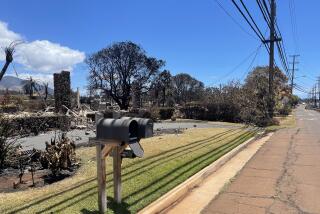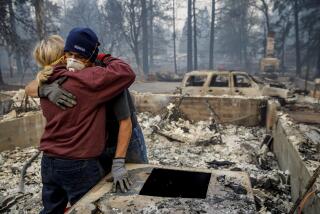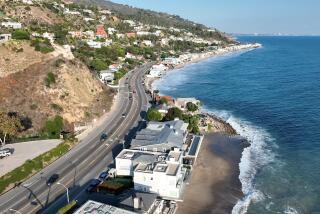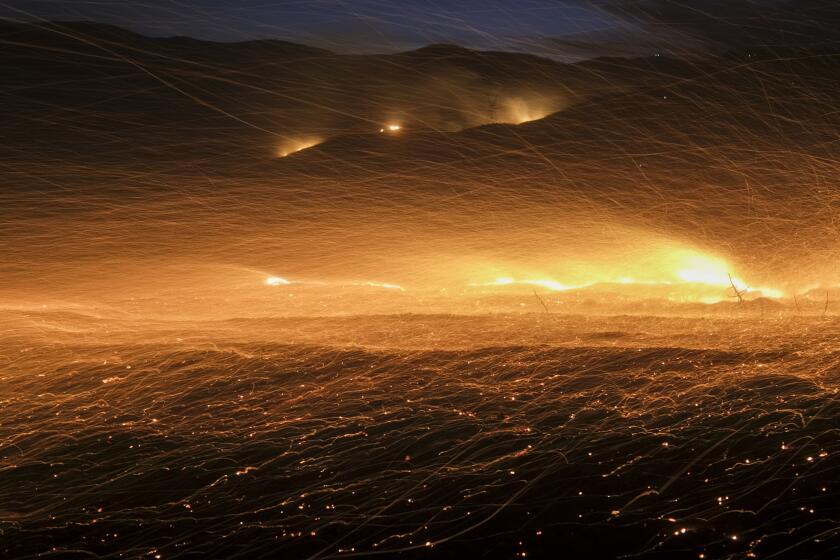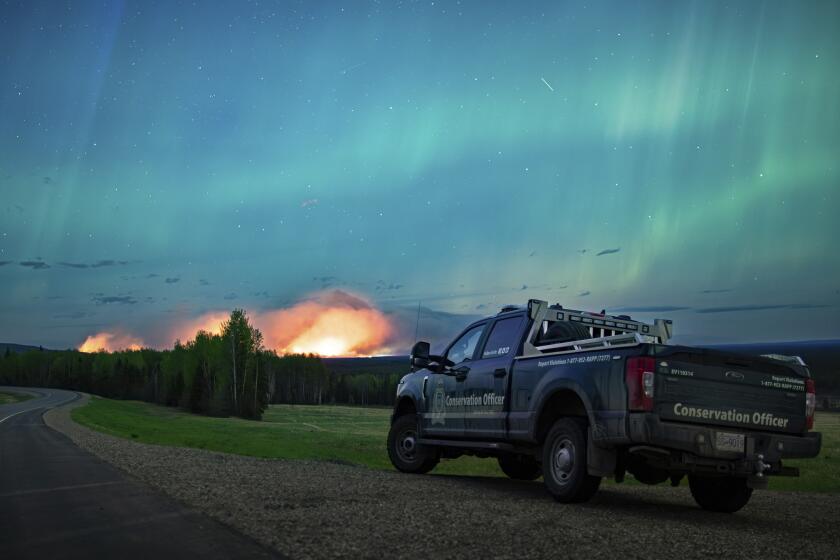Lessons of 1993 Blaze Cut Losses
It was fate and good firefighting, nature and human enterprise, that have so far saved Malibu this time around.
Residents scarred by the flames of the devastating Calabasas/Malibu fire of 1993 learned their lesson, clearing dry brush and installing water pumps to wet down their properties well in advance of this week’s blaze. Firefighters also were more prepared, using new tactics and a stronger aerial attack.
But what has also spared Malibu the destruction of hundreds of homes is that this time, the fire simply started one canyon to the west of the blaze three years ago. And although this fire has followed the same explosive southwesterly path toward the sea, this time there weren’t nearly as many houses or people in its path.
Instead, there has been mostly brush.
“I’d say Malibu definitely had a little grace extended this time,” said firefighter Dave Crall. “I don’t believe in luck, personally. But it was the location of the fire--it just burned through a less densely populated area.”
On Tuesday, as weary firefighters began to assess what went right and what went wrong, their initial conclusions were that residents and firefighters alike had done their homework as a result of the 1993 blaze that ultimately killed three people and caused $170 million in damage.
The lessons were applied long before the first wisps of smoke curled up from the chaparral near Stokes Canyon at 10:34 a.m. Monday, and throughout the long hours of wearisome firefighting that ensued.
The response to the fire, which has destroyed five structures, was heroic indeed, from residents with hoses to helicopter pilots dropping tons of water. But fire officials say all of that might not have made a difference had the blaze started just a bit to the east. If it had, it might have barreled through far more populated parts of Malibu, consuming hundreds of houses in its path.
As a grateful Los Angeles County Fire Capt. Steve Valenzuela concluded, “Mother Nature was good to us.”
Residents’ Readiness
Alarmed by the speed with which their beloved seaside community turned to kindling the last time, residents long ago broke out the weed whackers and cleared brush from their properties with a vengeance.
Since the 1993 fire, officials from the city of Malibu and Los Angeles County have spurred them on, with “vegetation reduction” workshops, training sessions, enticements--and even threats of prosecution if they didn’t abide by strengthened brush abatement regulations.
Thousands of residents responded, clearing more flammable brush from their yards than at any time in the past, fire officials said. Of 6,000 Malibu residences, only 100 were not in compliance as of two weeks ago, they said.
In Latigo Canyon, the hillside home of Walter and Fern Lea Peter came perilously close to destruction, but the couple’s once-lush yard had been cleared, allowing firefighters to push the flames back when they came within a few feet of the house.
“We won again!” exclaimed Walter Peter, 66, after the flames passed. Added his wife: “That’s what happens . . . when you’ve done your weed abatement.”
Sharon Barovski, president of the Malibu Road Property Assn., said her group has been in nearly 100% compliance with the city’s stringent brush-abatement regulations.
However, a neighbor along their two-lane artery between Pacific Coast Highway and the ocean--the state of California--may not have been.
Barovski’s husband, Harry, a Malibu city planner, complained Tuesday that nearby land owned by the state Department of Parks and Recreation was covered with dense brush when the fire struck. It caught fire, undermining the homeowners’ efforts somewhat.
“Every single millimeter of it burned,” Barovski said. Fortunately, firefighters doused houses along the road with water during the night, preventing significant damage.
State Parks and Recreation Department officials did not respond to calls seeking comment. Barovski said he had been complaining to them about the brush since the summer, but that only a small strip of the land had been cleared.
Businesses, like residents, heeded the call. Although Hughes Research Laboratories suffered only slight damage during the previous blaze, workers diligently cut back the thick, flammable brush around the seven-building complex tucked along Malibu Canyon Road. They also trimmed the explosive eucalyptus and palm trees ringing the area, and replaced many shrubs with flame-retardant plants.
As walls of flame encircled the complex Monday night, the company’s fire brigade saturated the rugged terrain with water. It worked. The flames never touched the buildings. Hughes official Frank Brady said he didn’t know the cost of the company’s fire prevention efforts. But “they were definitely well worth it,” he said.
Other homeowners appeared to have saved their homes by taking fire prevention measures into their own hands.
On Winding Way just west of Malibu, Anthony O’Rourke waited for the approaching flames with his portable pump and a hose.
After sending his family to safety, the pet supply company executive began spraying his two-story hilltop home with water pumped from his backyard swimming pool. Then he fled too, but not before telling Long Beach firefighters about the pump and ample supply of water.
Fire Capt. Mike Kinnee and firefighter Phil Cooms took advantage. “Is this pump helpful? Absolutely,” Kinnee yelled over the sound of the wind. “And he has nice terracing and clearance here. . . . We’ll make a stand.”
After the fire had passed, O’Rourke returned and took a long drink of milk from a carton in the refrigerator before stepping back outside to thank the firefighters. “My wife always kidded me spending so much money on landscaping and on cleaning the hill. And the pump,” said O’Rourke. He doesn’t think she’ll question it any more.
Firefighters’ Preparedness
Brush fires are best fought from the sky, and firefighters learned lessons from the 1993 fire too. They’re using fewer aircraft than they did then, they said. But they’re using better ones.
After the Calabasas/Malibu fire, county fire officials decided to lease two vaunted Super Scooper planes from the Canadian province of Quebec.
Despite their cost--$1.2 million for about two months of work during high fire season--county officials said Tuesday that they have come through their first test with flying colors. The bright yellow planes spent the last two days skimming the ocean, gathering 1,400 gallons of water and dropping it over flames. Although their accuracy has been hampered by gusting winds and hard-to-reach fires in steep canyons, “There is no question it is an advantage to have it,” said Supervisor Zev Yaroslavsky.
Among the arsenal of about 20 planes and helicopters used this week, firefighters also relied heavily on another weapon that they didn’t have in 1993--a helitanker. Also known as an air crane, the massive helicopter can siphon up to 2,000 gallons out of a swimming pool or other water source through a giant straw before hovering over a blaze and dropping its load.
Firefighter Crall said Tuesday that the bright orange helicopter, leased from the state for $7,500 an hour, performed even better than the Super Scoopers. “They were able to get a little bit closer to the fire and to move a little slower, so they had more accuracy,” Crall said, “and the wind didn’t affect the water drop as much.”
The county has also improved its emergency firefighting plan after reviewing its 1993 response.
Valenzuela, a department spokesman, said county firefighters developed better “pre-attack” plans after the 1993 fire.
Fire officials identified high hazard fire areas and mapped out different firefighting scenarios based on their particular needs. They also identified “safe refuge areas,” where residents could be evacuated.
“We kind of played a chess game out there,” Valenzuela said.
The department also improved its communications systems, adding more compatible frequencies that allowed a larger number of firefighters from different agencies to talk to each other.
Nature’s Kindness
But there was another factor that helped save Malibu.
Instead of starting in the more heavily populated enclaves near Cold Canyon, this week’s fire began just off the Ventura Freeway at Las Virgenes Road and sprinted down Stokes Canyon.
To be sure, the new fire came perilously close to many homes, sheds and trailers, burning a handful. But with fewer homes threatened, and more maneuverability due to less steep terrain, firefighters could direct their efforts to those structures in immediate danger.
This week, “50 or 60 homes max were threatened at one time,” Crall said. “At the [1993] fire, we had lots and lots and lots of homes threatened at one time.”
In 1993, the flames raced through hard-to-reach canyons, along winding but populated roads that made it nearly impossible for firefighters to do their work.
“In 1993 the areas hit were the Topanga area, Big Rock and Las Flores,” said Malibu City Councilwoman Carolyn Van Horn. “Those have extraordinarily difficult, narrow roads, cul-de-sacs and dead ends. It was difficult for firetrucks to get to them and to turn around.”
This time, the fire burned over areas where the terrain was rolling, with some flat, plateau-like areas.
This was crucial for water-dropping helicopters and fire-retardant bombers: It made it much safer for them to make their runs.
“Just having the ability to gently go up and down makes it safer for pilots and firefighters,” Valenzuela said.
The captain said the winds were not as fierce and hot as in 1993, when there were consistent gusts of 80 mph.
“No matter what we have in place,” Valenzuela said, “the wind and weather will dictate what happens.”
(BEGIN TEXT OF INFOBOX / INFOGRAPHIC)
BATTLE IN THE HILLS
Man and nature both played key roles in limiting the damage to Malibu Tuesday, where only a handful of buildings burned, compared to the loss of more than 350 structures in 1993.
THE HUMAN FACTOR
Stronger brush clearance efforts by individual residents and governments. Additional firefighting equipment including two Super Scoopers and one Helitanker.
THE HAND OF FATE
Although this week’s blaze followed the same southwesterly path, it started one canyon to the west, sweeping through an area with far fewer homes.
****
Western Malibu
* On west side, houses are newer, spaced farther apart, minimal landscaping.
* West side houses are huge, but built mostly of stucco with tile or metal roofs. The driveways are wide enough for three and four cars, leaving ample space for firetrucks.
* Terrain west of Pepperdine is more rolling, almost a wide, flat plateau in some areas, between the ocean and the Santa Monica Mountains that gives easier access to firetrucks.
****
Eastern Malibu
* Houses are closer together on east side, with wood and shake roofs, more mature flamable landscaping.
* Eastern Malibu has steeper terrain, with more narrow roads and driveways that make tough going for firetrucks.
****
1993 Fire Origin
1993 fire started farther east in Calabasas; wind drove it east of Malibu Canyon/Civic Center area.
****
Key areas saved
1) Monte Nido
2) Malibu Bowl
3) Malibu Hills
4) Pepperdine University
More to Read
Start your day right
Sign up for Essential California for news, features and recommendations from the L.A. Times and beyond in your inbox six days a week.
You may occasionally receive promotional content from the Los Angeles Times.
